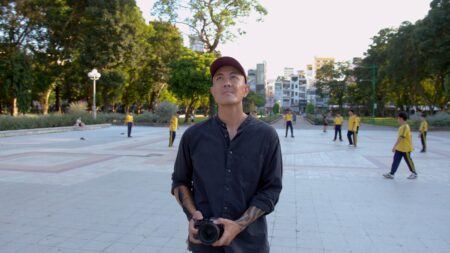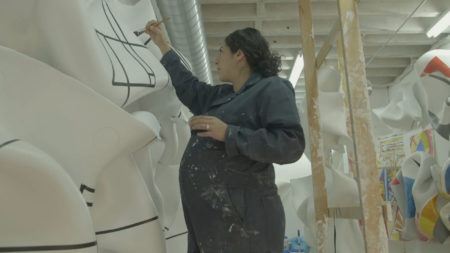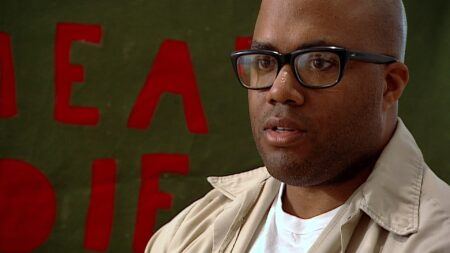Continue playing
(Time remaining: )
Play from beginning
Continue playing "{{ controller.videos[controller.getVideo(controller.currentVideo)].segmentParentTitle}}"
{{controller.videos[controller.getVideo(controller.currentVideo)].title}} has ended.
Real BiographyTrenton Doyle Hancock
Speaking from James Cohan Gallery, New York in late 2012, artist Trenton Doyle Hancock describes how his work has evolved over the past ten years. When Art21 first filmed the Houston-based artist in 2002, all of his paintings and drawings were filtered through a fictional narrative and characters he called “Mounds” and “Vegans.”
Hancock created these stories to give structure to his wide-ranging interests and ideas. The Mounds and Vegans have appeared in numerous exhibitions, a storybook, a mural at the Dallas Cowboys Stadium, and even a ballet. It was while watching the ballet that Hancock realized it was time to move on from the tale.
Credits
Producer: Ian Forster. Consulting Producer: Wesley Miller & Nick Ravich. Interview: Ian Forster. Camera: Ian Forster, Rafael Salazar Moreno, Joel Shapiro & Ava Wiland. Sound: Stephanie Andreou & Ava Wiland. Editor: Morgan Riles. Artwork Courtesy: Trenton Doyle Hancock, Ballet Austin, James Cohan Gallery & Dallas Cowboys Stadium. Archival Images Courtesy: Trenton Doyle Hancock. Photography: Tony Spielberg. Theme Music: Peter Foley.
Closed captionsAvailable in English, German, Romanian, Italian, Japanese, Korean, Chinese, Italian
Through the Art21 Translation Project, multilingual audiences from around the globe can contribute translations, making Art21 films more accessible worldwide. Translate this video now.
Interested in showing this film in an exhibition or public screening? To license this video please visit Licensing & Reproduction.
Trenton Doyle Hancock’s prints, drawings, and collaged-felt paintings work together to tell the story of the Mounds—a group of mythical creatures that are the tragic protagonists of the artist’s unfolding narrative. Each new work by Hancock is a contribution to the saga of the Mounds, portraying the birth, life, death, afterlife, and even dream states of these half-animal, half-plant creatures. Influenced by the history of painting, especially Abstract Expressionism, Hancock transforms traditionally formal decisions—such as the use of color, language, and pattern—into opportunities to create new characters, develop sub-plots, and convey symbolic meaning. Balancing moral dilemmas with wit and a musical sense of language and color, Hancock’s works create a painterly space of psychological dimensions.
“The same kind of reflexive thing that was going on with the work before that was me and these codified characters, then became me and my real biography.”
Trenton Doyle Hancock
Art & Family
Tim Hawkinson
Artwork Survey: 2000s
Trenton Doyle Hancock






